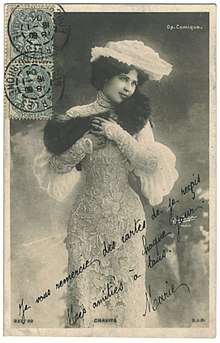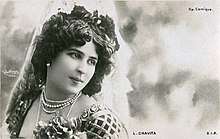Luz Chavita
Luz Chavita (1880–?) was the stage name of Luisa Lacalle, a Spanish dancer who gained international fame during the Belle Époque and was a leading dancer in Paris before returning to Spain to become an entrepreneur.
Luz Chavita | |
|---|---|
 | |
| Born | 1880 Jerez de la Frontera, Spain |
| Nationality | Spanish |
| Other names | Luisa De la Calle, Lulu |
| Occupation | dancer |
| Years active | 1894–1908 |
Biography
Luisa Lacalle was born in 1880 in Jerez de la Frontera, Spain to a poor family originally from Seville. Showing promise for dancing at an early age, she began taking dancing classes with Juana la Macarrona. By the time she was fourteen, Lacalle was dancing professionally using the artistic name Lulu or Luz Chavita.[1] Having gained a reputation for her talent, she moved to Paris with a letter for introduction for the Count de Pradere (also known as Daniel de Carbalho y de Prat). Pradere introduced her to Antonin Perivier and Fernand de Rodays, the directors of the newspaper Le Figaro. The pair frequently gave entertainments for aristocratic subscribers and invited Chavita to appear. Almost overnight, she became a sensation and was proclaimed as a new star.[1]
Before her official debut, Chavita studied with Madame Mariquita, where she studied for the next two years.[1] Soon after, she had her official debut at La Scala and from there she went to the Folies Bergère, where she was hired along with Juanita de Frezia, La Belle Gerrero, and Mlle Hernandez, to dance their Spanish repertoire which showed off their décolletage and bare legs.[1][2] She toured Europe, visiting Berlin, Budapest, London, Vienna and other major cities and then was engaged at El Alcázar in Marseilles.[1] By 1898, she was among the soloists performing at the Ballet de l'Opéra Comique along with such dancers as Régina Badet, Aïda Boni, Jeanne Chasles, Cléo de Mérode and Stacia Napierkowska. The theater soon earned the reputation as the "most artistic of Paris".[3]

At another of Le Figaro′s entertainments in 1899, Chavita enhanced her fame even more. The newspaper had sided with Alfred Dreyfus and agreed to publish documents which would impact the government handling of the Dreyfus affair. The police planned a raid to confiscate the documents, but when they arrived, Chavita began her performance, delaying the search until the documents could be safely hidden.[1] The story was retold in newspapers ranging from Madrid to the United States.[4][5][6] Other noted performances at the Opéra-Comique were her portrayal of Carmen in 1901 and in la Danse au temps de Gavarni (The Dance in the Time of Gavarni) in 1903 in which her polka was called exquisite.[7][8]
Chavita saved all of her earnings, investing them carefully, and announced her retirement from the stage in 1905. She reconfirmed she was leaving Paris in 1908 and returned to Seville, where she bought real estate on Santa Clara Street, and later another house on Goyonetta Street. She outfitted her homes with modern refinements from Paris, took care of her parents in their old age, and purchased a vineyard in Jerez, which she administered for many years.[1][9][10]
Death and legacy
Chavita's death date is unknown.[1] In 1905, the ceiling of Paillard Restaurant of Paris, where aristocrats and royalty gathered to dine was painted with a tribute called Women of the Twentieth Century by Lucien-Victor Guirand de Scévola. Chavita's was one of the likenesses that was included.[11]
References
Citations
- Jiménez García 2016.
- Gutsche-Miller 2015, p. 17.
- Bulletin D’information du Centre Chorégraphique National 2007, p. 6.
- Jiménez 2016.
- El Adelanto 1899.
- The Evening Gazette 1899, p. 2.
- La Corespondencia de España 1901, p. 2.
- Le Figaro 1903.
- & Andalusian Patrimony & History 2015.
- Cavestany 1908.
- Wassenaar 2015.
Bibliography
- Cavestany, Genaro; Ortiz Nuevo, José Luis (translator) (7 October 1908). "Una jerezana en París a comienzos del siglo XX: Luz Chavita" [A Jerezana in Paris at the beginning of the 20th Century: Luz Chavita] (in Spanish). Mexico City, Mexico: El Correo Español. Archived from the original on 1 July 2017. Retrieved 1 July 2017 – via El Eco de La Memoria.
- Gutsche-Miller, Sarah (2015). Parisian Music-hall Ballet, 1871–1913. Rochester, New York: Boydell & Brewer. ISBN 978-1-58046-442-0.CS1 maint: ref=harv (link)
- Jiménez, José Luis (18 July 2016). "Luz Chavita, una jerezana que triunfó en el París de entresiglos" [Luz Chavita, a Jerezana who triumphed in the Paris at the beginning of the century] (in Spanish). Jerez, Spain: Mas Jerez. Archived from the original on 16 September 2016. Retrieved 1 July 2017.CS1 maint: ref=harv (link)
- Jiménez García, José Luis (1 August 2016). "Luz Chavita, la jerezana que triunfó en el París de la Belle époque" [Luz Chavita, the Jerezana who triumphed in the Paris of the Belle Époque]. Jerez de la Frontera, Spain: Diario de Jerez. Archived from the original on 1 July 2017. Retrieved 1 July 2017.CS1 maint: ref=harv (link)
- Wassenaar, Rik (20 March 2015). "Le plafond du Restaurant Paillard (1905)". Guirand de Scévola Art (in French). Rik Wassenaar. Archived from the original on 1 July 2017. Retrieved 1 July 2017. Self-published by with citations to source materials.CS1 maint: ref=harv (link)
- "A la Comédie" [At the Comedy]. Le Figaro (in French). Paris, France. 24 April 1903. Archived from the original on 1 July 2017. Retrieved 1 July 2017.
- "La Vida en Paris" [Life in Paris] (in Spanish). Madrid, Spain: La Corespondencia de España. 24 November 1901. p. 2. Retrieved 1 July 2017.
- "Luz Chavita". adepasevilla (in Spanish). Seville, Spain: Asociación para la defensa del patrimonio histórico-artístico de Andalucía. 25 November 2015. Archived from the original on 1 July 2017. Retrieved 1 July 2017.
- "Plages d'histoires: La danse à Biarritz #29" [Beach stories: The Dance of Biarritz #29] (PDF). Bulletin d'Information du Centre Chorégraphique National (in French). Biarritz, France: Ballet Biarritz (34): 5–6. June 2007. Archived from the original (PDF) on 1 July 2017. Retrieved 1 July 2017.
- "Raided by Police". The Evening Gazette. Cedar Rapids, Iowa. 3 April 1899. p. 2. Retrieved 1 July 2017 – via Newspaperarchive.com.

- "(untitled)" (in Spanish). Año 15 (4228). Madrid, Spain: El Adelanto. 2 April 1899. p. 3.
Dicen dé París que la bailarina española Luz Chavita, conocida en Madrid por Lú Lús se hallaba bailando ante un numeroso público, en uno de los salones de El Figaro, cuando llegó la policía con objeto de recoger las planas del periódico que sirvieron para la publicación de los diversos secretos del asunto Dreyfus. Al entrar la policía, hubo un gran momento de sorpresa. La citada bailarina preguntó lo que ocurría y quiénes" eran los individuos que penetraban en los salones, á lo que le contestaron que era la justicia. Entonces Luz Chavita instó á la comisión á que subiera. Hízolo ésta así y Luz, tomando una copa de Champagne, exclamó:—¡vaya por la policía! y bailó un tango dislocante, siendo Ovacionada repetidas veces, incluso por los representantes de la justicia. (It is said in Paris that the Spanish dancer Luz Chavita, known in Madrid as Lú Lú, was dancing before a large crowd in one of the rooms at El Figaro when the police arrived to collect the broadsheets of the newspaper that were publishing the various secrets of the Dreyfus affair. When the police entered, there was a moment of great surprise. The mentioned dancer asked what was happening and who were the individuals who had entered the salon, to which they replied that they were justice. Then Luz Chavita urged the commission to rise. This was done and Luz, having a drink of Champagne, exclaimed: "Well, to the police!" And she danced a disguising tango, which received repeated ovations, even by the representatives of justice)